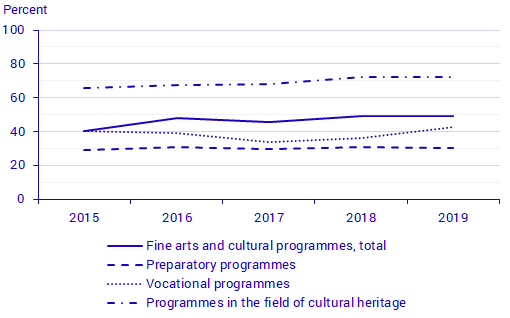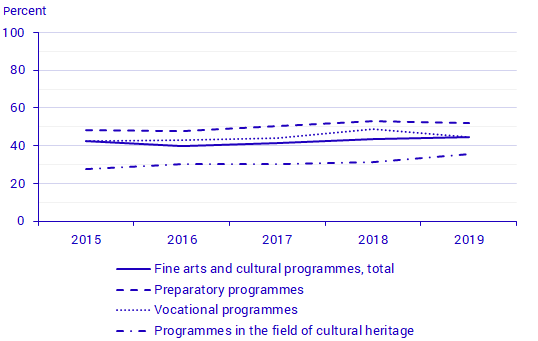Fine arts- and culture programmes and certain other programmes, 2019
Two in five students in fine arts and cultural programmes have highly educated parents
Statistical news from Statistics Sweden 2020-10-13 9.30
Admitted students who commenced studies in fine arts and cultural programmes have highly educated parents. Around 40 percent of admitted students who commenced studies in 2015-2019 have at least one parent with post-secondary education three years or longer. Furthermore, a large proportion of those who commenced studies already have a high level of education.
Post-secondary programmes in fine arts and culture have been available since autumn 2015. The programmes are grouped into three types of education with different aims. The aim of higher education preparatory programmes is to prepare students for higher education programmes that can lead to an academic degree in the arts. The aim of vocational programmes is to develop students’ skills in the arts and cultural field. The aim of programmes in the field of cultural heritage is to train students to conserve and develop cultural heritage.
Large proportion of students already have a high level of education
There are around 3 000 admitted students who commence studies in fine arts and cultural programmes every year. Just under half of these students already have a post-secondary education. This proportion has been virtually constant throughout the period 2015-2019. The proportion of students who already have post-secondary education varies between the different types of education. Around 70 percent of the admitted students who commenced studies in the field of cultural heritage already had a post-secondary education. This proportion was smaller among students admitted to preparatory programmes for higher education and vocational programmes. Among students who commenced studies each year, 30 percent and 40 percent respectively already had a post-secondary education.

Two in five students had highly educated parents
Around 40 percent of the students who commence fine arts and cultural programmes each year have at least one parent with a post-secondary education of three years or more. The proportion of students with highly educated parents has been virtually constant throughout the period 2015-2019. The largest proportion of students with highly educated parents is noted among those admitted to preparatory programmes for higher education. Roughly half of the admitted students who commence studies in this type of education have at least one highly educated parent.

The proportion of admitted students with highly educated parents is greater in fine arts and cultural programmes than in higher vocational education and roughly at the same level as among first-year students in higher education. The proportion of students with highly educated parents was 21 percent among students admitted to higher vocational education in 2018 and 39 percent among first-year students in higher education in the academic year 2017/18. In the fine arts programmes, the proportion of admitted students who have highly educated parents is smaller than among first-year students. In the academic year 2017/18, 59 percent of first-year students in fine arts programmes in higher education had at least one highly educated parent.
Definitions and explanations
Admitted students who commenced studies refers to all persons who are or were students during a programme session, including those who entered later during the programme and those who dropped out of the programme. Persons are counted in each programme session, and may therefore be included in the statistics two or more times in the same year. This means that the number of admitted students who commenced studies is not the same as the total number of students.
Previous level of education and parents’ level of education are both classified according to the Swedish education nomenclature (SUN). Information on the level of education is available in the Register of Education. If data on parents’ education when the student was 12 years old is available, this information is used primarily.
Information on parents’ level of education among students admitted to higher vocational education was retrieved from the memorandum “Social snedrekrytering till yrkeshögskolan mindre än till högskolan”.
(see www.scb.se/uf0701). (Only available in Swedish.)
Information on parents’ level of education among first-year students in higher education and first-year students in fine arts programmes in higher education was retrieved from the report “Högskolenybörjare 2017/18 och doktorandnybörjare 2016/17 efter föräldrarnas utbildningsnivå”
(see www.scb.se/uf0212). (A summary is available in English.)
Publication
A more detailed presentation of the results is available in the report:
Utbildningsbakgrund och social bakgrund för antagna som påbörjat konst- och kulturutbildningar
Statistical Database
More information is available in the Statistical Database
Feel free to use the facts from this statistical news but remember to state Source: Statistics Sweden.
